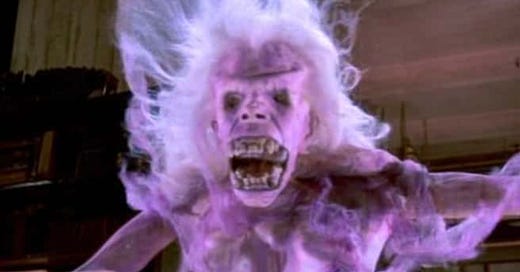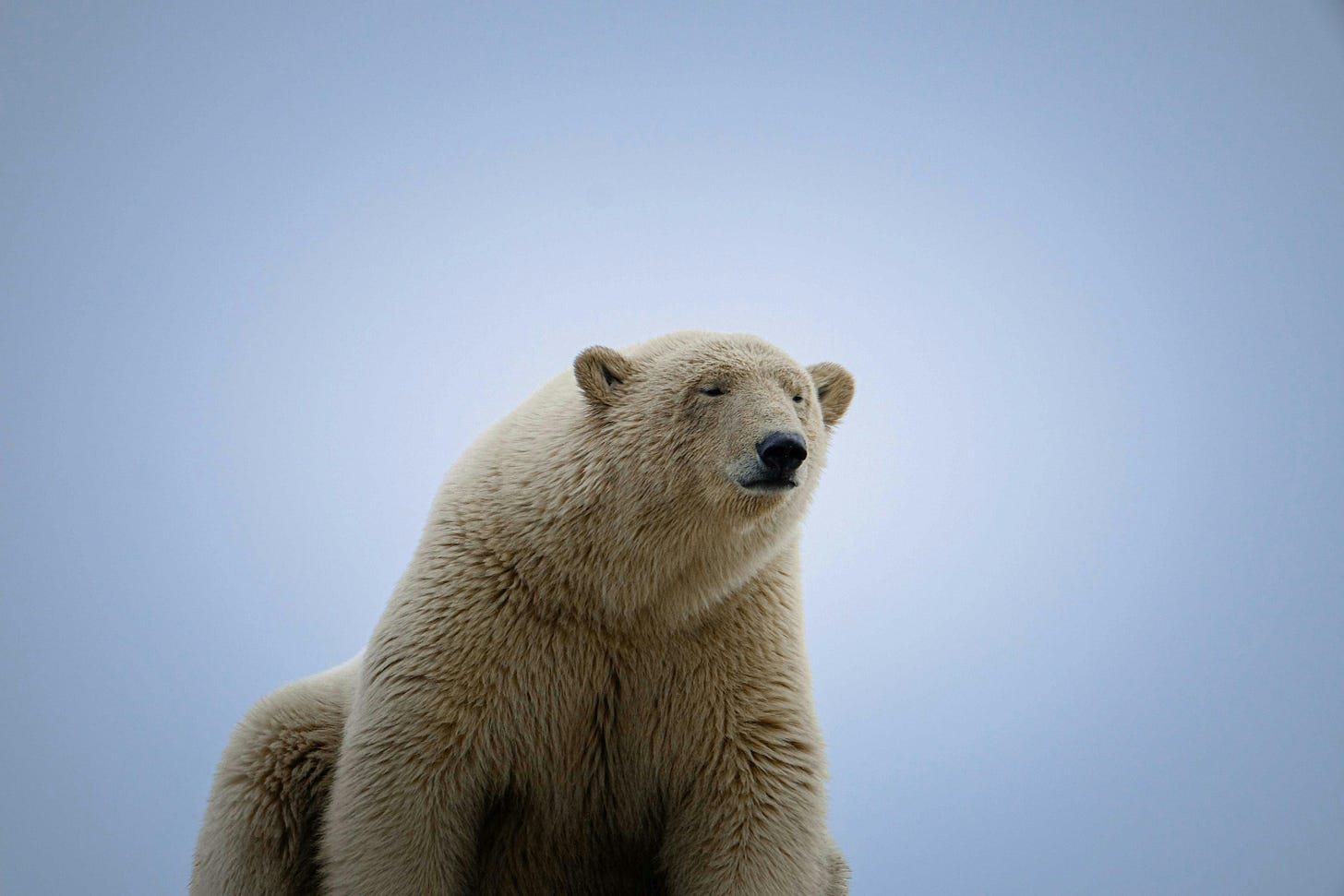Monsters never scared me. My first conscious fear wasn’t of the bogeyman, it was of actual people in my actual life. It was of getting in trouble, either at school or worse, with my mother.
This terror was a monster itself, huge and roaring, threatening banishment to an icy tundra. It promised humiliation. It brought crying and yelling and yet from a very young age I stumbled into trouble on an almost daily basis, so that monster was a constant companion

.
Because Substack is not therapy I’ll spare you the details but I bet many of you will relate to the part where the monster morphs into a people-pleasing, validation-seeking, conflict-avoidant demon, right?
There are heaps of different kinds of fear, ranging from social concerns to survival fears to full-blown phobias, but almost any fear can be traced back to death anxiety. Not all are as obvious as my adolescent terror of being murdered by Charles Manson. Fear of rejection, for example, is underpinned by a primal fear of being ostracised; if you’re voted off the island, you perish.
The parts of our brains that process fear (the sympathetic nervous system) tend to work in quite a binary manner. Either you’re safe, or YOU COULD DIE. Adrenaline and cortisol pump through our bodies, our heart rate increases and we start rationalising that feeling into modern-day parlance. That sabre-toothed tiger becomes your boss, your lover, the creepy dude at the bus stop, or a dark fantasy of impoverishment.
My own stupid brain seems to malfunction more often than not. When I should feel afraid, it sometimes fails to rise to the task. My parents used to tell a story of being at a pool with little four-year-old me. I want to swim, I said, and off I ran, literally jumping into the deep end. My vague memory is of blue green immersion but no fear. I don’t remember being rescued either but here I am, not drowned.
I was robbed the other night due in part to my lemon of a sympathetic nervous system. A faceless person asked to meet me outdoors at night to buy a phone I’d advertised online. Heedless of my quiet apprehension and wilfully optimistic as that four-year-old, I toddled down the footpath and handed my phone to a waiting hoodlum in a hoodie, who promptly turned and ran away with it.
However, the following night my wife and I attended a posh soiree at a Paddington art gallery; as we approached, the sight of dozens of beautiful people chatting easily and sipping champagne, not a hoodie in sight, filled me with a fleeting but profound anxiety.
Here are the lessons I’ve learned about fear:
Becoming acquainted with fear can be helpful in deciding whether to let it guide our behaviour. Ignoring it, wilfully or not, means we walk into stupid, dangerous situations. If we drown it with alcohol we proceed to make stupid, dangerous decisions. If we fail to acknowledge it and put it into perspective, it becomes a barrier between us and other people or opportunities (for example, I’d have left the gallery opening, or retreated into the corner on my phone, and missed out on wonderful conversations and connections). I really love Tara Brach’s beautiful R.A.I.N. meditations (Recognise, Accept, Investigate, Nurture), which gently guide us to regulate uncomfortable feelings in a compassionate and progressive manner.
Fear serves to keep us safe. It doesn’t care about our happiness, or whether we have a great quality of life. It simply wants us alive, and if it had its way we would never, ever take risks – especially not one as public as writing this blog. Or jaywalking across Elizabeth Street during peak hour to catch a bus. If we make friends with fear and listen to what it has to say, then we (that is, the conscious self) get to decide whether or not we want to share its concerns for our welfare. If so, we walk down to the crosswalk. If not, we can thank it kindly for its service and go ahead with our plans.
It’s interesting to fully engage with a fear by boldly mapping out the outcomes and likelihood of worst-case scenarios. For example, using the example of the gallery soiree, that would be something like all the beautiful people there ignoring or mocking me. I’d feel shame and humiliation; I’d go home and with time those feelings would fade. The likelihood of that happening, though, is extremely low because those people were polite, and had no beef with me. Facing the outcomes of the worst possibilities and then developing strategies to manage them is weirdly comforting, I promise. Tim Ferriss has a tool to do this called Fear Setting that I’ve found useful.
If doing a Big Thing is frightening but needs to be done regardless, try to focus instead on the little steps that must be taken to get there. Getting a divorce, doing a PhD, getting your driver’s licence – all terrifying, right? I like this analogy: when you climb a mountain, you focus on one step at a time because broadening your focus would be overwhelming. There’s a reason you check out the view at the peak and not during the process. Mountains are tall y’all!
Anticipatory fear is mostly worse than the actual scary event when it occurs. Sleepless nights and lost time spent ruminating are miserable, exhausting, and bad for the health. This is what my own therapist recommends I say to my anxiety: “Thanks so much for trying to help. What would be best for me to prepare for the Scary Thing would be to get some rest (or do some work), so I’m going to put my energy toward something else now and get back to you later.”
It’s pointless to tell your brain not to think about something without giving it another bone to chew on. Try this: don’t think about a polar bear. See? The secret is to DISTRACT. Put your mind to something that is engaging, creative, or requires concentration.
Ring fence time to deal with a frightening topic. Say you’re facing bankruptcy. Allow yourself to think about, journal, discuss, do the administration and research for bankruptcy for, say, 45 minutes each day, and schedule it in. When you catch yourself in ruminatory fear, remind yourself gently that you’ll get back to that topic at 3pm, and then move on quickly to something else (see point above).
Everyone, and I mean everyone, experiences some level of social anxiety, and what’s super annoying is that the anxiety convinces us that we’re the only one suffering. I’ve worked with celebrities, politicians, folks at the very top of their game, and this is the one common denominator that I see in my clinic. That, my familiar, is a very helpful thing to remember as you walk (head high, shoulders back) into your next gathering of beautiful people.
I don’t fear getting in trouble so much anymore since I’ve watched myself cope with really being in the shit, I finished school and my poor mother, rest her soul, is long gone. Charles Manson is far too old now to escape prison and knife-murder me, and my hope is that I’ll keep moving through my fears one soiree at a time. Will you join me?
[Edit to add: I am relieved to learn that Manson died in 2017, and with him any chance of bloody murder at his hands. Not sure how I missed that!]





Shockingly, getting a tattoo that says "Fearless" on my wrist did not obliterate my anxiety, social or otherwise. It's a cute little reminder, though, to keep facing shit and proving it's not really the Big Bad I think it is.
Loving the blog, Julie!!
Manson died in 2017. If you really want to exorcise that particular demon, you might try Tarantino's "Once Upon A Time In Hollywood". No spoilers but ... it gets the job done.